The Ssi-ruuk (pronounced /'si ruk/), Ssi-ruu in singular form, were a saurian species that invaded from the Unknown Regions of the galaxy and initiated the Invasion of Bakura in 4 ABY, shortly after the Battle of Endor. This race relied on a technology called entechment that involved extracting the life-energies of sentient beings and using them as power sources for their mechanical technology. They had a sizable war fleet and ruled an empire called the Ssi-ruuvi Imperium in the Ssi-ruuk Star Cluster near the galaxy's rim.
Ssi-ruuvi society was deeply compartmentalized—being dominated by a rigid caste system based on skin color which signified one's socio-economic standing. As a species, most Ssi-ruuk were xenophobic towards members of other species due to their stringent religious beliefs and the compartmentalized state of their society. Due to the remote position of their home territory in the Ssi-ruuk Star Cluster and their religious fear of dying on an unconsecrated world, few Ssi-ruuk traveled outside their Star Cluster. Thus, they remained largely unknown to the rest of the galaxy, and contact with outsiders was limited even in the days of the New Republic and the Galactic Alliance.
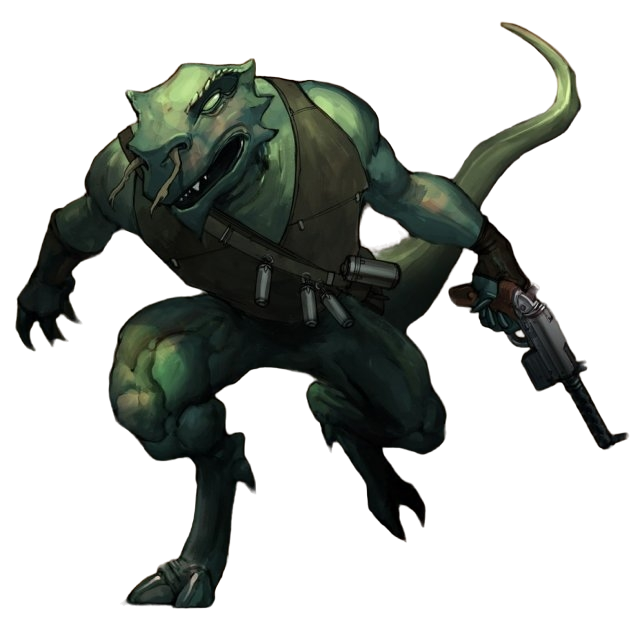
A green Ssi-ruu
The Ssi-ruuk were a large bipedal saurian species that displayed traits from avians. They walked on two powerful hind legs with balance attained by a muscular tail along with two upper limbs that sported three prehensile claws. While they were reptilians, they were in fact a warm-blooded species. An average adult reached a height between 1.9, 2, to 2.2 meters (approximately 7.2 feet) and weighed close to 350 kg (~770 pounds). They were notable for their physical strength, comparable to that of a typical adult Wookiee. It was known that their race moved with remarkable grace and speed for creatures of their size. Their skin was so thick that it could withstand blaster shots with only minor burns to show for it. The massive bodies of an adult Ssi-ruu were covered in shining scales that ranged in color from brown to turquoise. They had long beak-like muzzles which contained sharp teeth and used their talons to kill prey as they were carnivores by nature.
In terms of eyesight, Ssi-ruuk were extremely sensitive to light which led to them holding triple eyelids in order to protect their vision from sudden bursts of illumination. Their large black eyes possessed the traits common with most reptilian species namely that they suffered from poor eyesight. The unusual structure of their eyelids made them far less susceptible to being blinded by sudden flashes of light. Despite this being the case, the species did not rely on their eyes alone the way Humans did. Instead, they made use of their keen sense of smell which was made potent by two forked "tongues" that emerged from their nostrils. This heightened sense of smell allowed them to determine the emotional state of their associates simply due to change of scent thus allowing Ssi-ruu to "read" an individual. These olfactory sensory organs were typically known as "scent tongues" that were black and flickered out when used. This was only the case once a Ssi-ruuk was familiar with the "scent" of a being which allowed them to detect signs of deception and thus making it hard for others to lie to them. However, at the same time, they found the scent of other species to be distasteful. Their own odor was described as being both strong and acrid that had the distinct scent of reptilians.
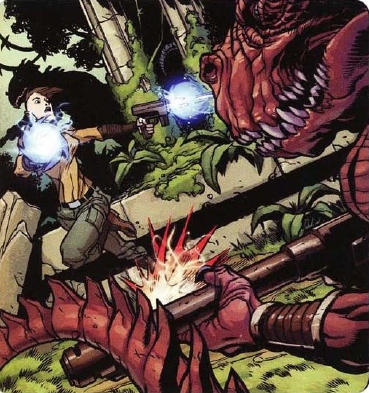
Two Ssi-ruuk soldiers surround a Human gunslinger.
The Ssi-Ruuvi language was made up by a series of musical tweets and whistles. This complex language made use of bird-like honks, whistles, growls, and throat clicks. Several of the higher pitches in the Ssi-ruuvi vocabulary were above the Human hearing range. Ssi-ruuvi chord-phrases were able to convey a great deal of information in a few notes. It was believed that species such as Humans were either unable to or struggled to speak their tongue. This was because their mouths were unable to speak the critical components of the language. The one example of a Human speaking Ssi-ruuvi was noted by the native speakers as being a halting and stuttering version of their own language. Instead of wearing clothing, they wore bandoleers which carried their tools, weapons, and other equipment. This led to their species finding the concept of covering a body in clothing to be a humorous idea. As such, they did not wear anything that covered their thick scaly hides.
The average lifespan of a Ssi-ruu was anywhere between 100 to 120 standard years, though members of their ruling hierarchy lived far longer. Children were considered to range between the years of 1 to 5 whereupon they were held as young adults when they were 6 to 10 years. Afterwards, they were held as adults from the age of 11 years to 55. A Ssi-ruuk reached middle age from 56 to 90 years of age after which they entered old age from 91 to 115. Those Ssi-ruuk that were older than 116 years were considered venerable elders amongst their kind.
It was believed that there were no Force users amongst the Ssi-ruuk and as a species as they were blind to it.
The Ssi-ruuvi Imperium had two seats of power; the Conclave, the religious body, and the Elders' Council, the political body. The Conclave and the Elders Council often competed for control of the empire and only the leader of the Imperium could prevent civil war from happening. The leader of the Imperium was known as His Potency the Shreeftut and was the supreme ruler of the Ssi-ruuvi Imperium. These two councils worked in an advisory capacity for the Shreeftut. Ssi-ruuvi society itself was largely clan based with it being entrenched in tradition and family history. The clans were headed by patriarchs and those that demonstrated charisma were able to command several clans. Control of a large number of clans earnt their patriarch a great deal of respect from their peers.
As with the long-extinct Sith species, Ssi-ruuvi society was compartmentalized by a rigid hereditary caste system. However, unlike the former, the latter's caste system was based solely on skin color. Their caste system comprised six main groups: blue, gold, yellow, red, black, and green. The skin color of a Ssi-ruuk symbolized his socio-economic standing in society. One color dominated each Ssi-ruuk's body and it was forbidden to mate with a different colored Ssi-ruuk. Offspring from mixed births were brown hued and were regarded as illegitimate; consigned to the lowest and most menial of positions in society. There was also a related species known as the P'w'ecks that were considered to be an inferior race and used as slaves.
The known castes included:
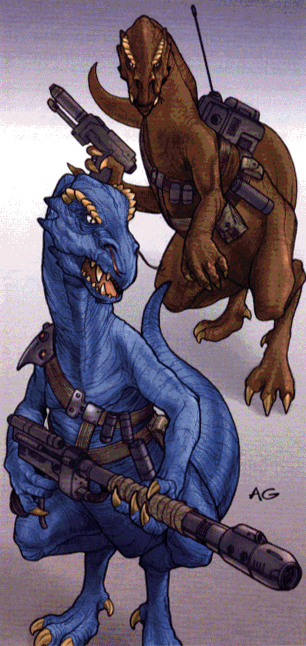
Blue and brown Ssi-ruuk
- : Blue Ssi-ruuk representing the noble caste were the politicians and leaders of Ssi-ruuvi society and held most of the political positions; dominating the executive Elders' Council which administrated the Imperium. They were distinguished from other Ssi-ruuk by their blue scales, smaller body size and longer tails. They were the highest caste and thus they received the most honor and praise. They tended to be, as a caste, extremely perceptive and ambitious. An example of this caste was Sh'tk'ith, commonly known as Bluescale.
- : Gold Ssi-ruuk were the religious caste of Ssi-ruuvi society. They were small in number and stature but dominated the Conclave which was entirely concerned with religious affairs. Gold Ssi-ruuk also performed religious ceremonies like the Consecration Ceremony which "consecrated" foreign planets to enable their annexation by the Imperium.
- : Yellow Ssi-ruuk studied the sciences and operated the technology employed by the Ssi-ruuvi Imperium.
- : Red Ssi-ruuk comprised the military caste. These Ssi-ruuk tended to be broader and stronger than other Ssi-ruuk and also had a predatory nature as well, these Ssi-ruu also have the ability to not be sensed when they are alone or in pairs. An example from this caste was AdmiralIvpikkis who commanded the first invasion of Bakura.
- : Green Ssi-ruuk were the largest caste. This caste was the lowest that still possessed respect. They had never held any position of power, but staunchly upheld the caste system as workers.
- : Very rare; worked as assassins and espionage agents for the Imperium. Honored among other Ssi-ruu tribe members.
- : Brown Ssi-ruuk were considered the outcasts of Ssi-ruuvi society as they were the offspring of two Ssi-ruuvi from two different castes. Since class intermarriage was strictly forbidden in Ssi-ruuvi society, many of them were destroyed at birth. They performed the most menial jobs in Ssi-ruuvi society. It was commonly believed that they were the ancient progenitors of the P'w'ecks. According to the G'nnoch, the birth of a multi-colored Ssi-ruu known as the Keeramak would herald a popular rising by the oppressed brown Ssi-ruuk and P'w'ecks. Following the punitive Chiss/New Republic incursions circa. 4 ABY, the Keeramak was born.
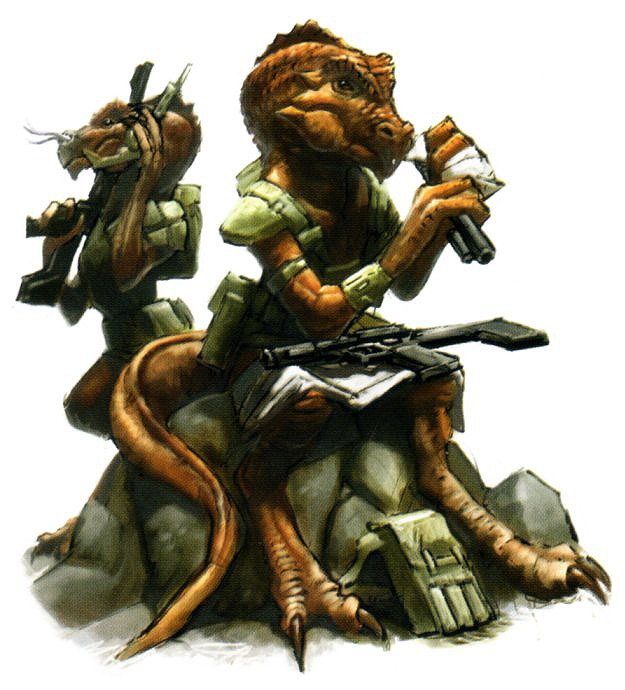
Two Ssi-ruuk warriors relaxing.
Ssi-ruuvi culture was influenced by two major factors—their speciesism and their religious beliefs. Thus, they came to believe that they were physically, mentally and spiritually a superior race. As a consequence of this prejudice, they viewed themselves as inherently superior to all other species while all other species were inferior. Culturally, the Ssi-ruuk displayed a speciesist attitude towards other species; regarding them as fit only for slavery and entechment—which utilized the life energies of another sentient being as a source of energy for their mechanical technology.
This attitude affected their relations with other sentient species they interacted with ranging from their lowly saurian P'w'eck cousins to the advanced mammalian Human and Chiss civilizations. Consequently, the Ssi-ruuk sought to conquer and to subjugate other civilizations to utilize their labor and resources. In fact, the majority of the Ssi-ruuk dedicated their lives to the preservation and expansion of their Imperium at the cost of subjugating other races. As a result, relations between the Ssi-ruuk and the neighboring powers like the Chiss Ascendancy, Galactic Alliance and the Yuuzhan Vong were virtually non-existent as of 28 ABY. However, they did not share the same genocidal beliefs that influenced the Yevetha of the Duskhan League during the Yevethan Purge and Black Fleet Crisis.
This speciesism was justified by their religious beliefs as they were an intensely spiritual people. According to their sacred text known as the G'nnoch, four eggs were formed at the creation of the universe. From the first hatched Ssi and P'w'itthki, fathers of the Ssi-ruuk and P'w'eck species respectively. Ssi's children hatched from the second egg, while P'w'itthki's children hatched from the third egg. The fourth egg was reserved for those Ssi-Ruuk who earned a place in the afterlife. Eventually, Ssi fought with P'w'itthki and defeated him. After his defeat, Ssi allowed P'w'itthki's hatchlings to live on the condition of serving the children of Ssi for all eternity. This myth thus explained the beginning of the relationship between the Ssi-ruuk (hatchlings of Ssi) and the P'w'ecks (hatchlings of P'w'itthki) and their concept of supremacy over all other sentient species.
One important concept in Ssi-ruuvi culture was the belief in the existence of souls and an after life. Most Ssi-ruuk placed great value on the souls of their own kind and believed that should a Ssi-ruu die in an "un-consecrated world", his soul will forever wander the universe alone. As a result, most Ssi-ruuk avoided direct combat when away from their homeworld. This belief explained why the Ssi-ruuk rarely traveled into the galaxy and remained in their star cluster. However, resources began dwindling in their isolated space; forcing the Ssi-ruuk to expand their Imperium into the fringes of the known galaxy by 1 BBY. Around that time, Emperor and Dark Lord of the Sith Palpatine made contact with the species through the Force and offered them dozens of worlds and millions of humans to entech in exchange for the use of Ssi-ruuvi entechment technology.
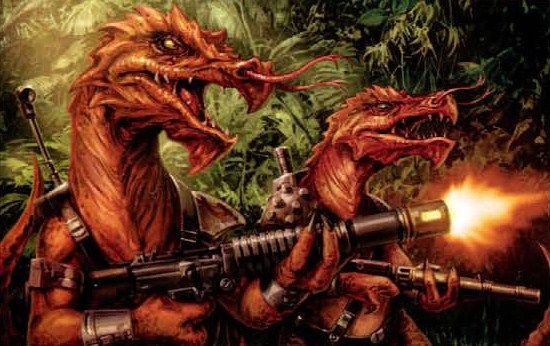
Ssi-ruuvi warriors.
Another cultural concept was the belief that if a Ssi-ruu died away from their "consecrated" homeworld of Lwhekk or their star cluster, his soul was destined to wander the universe for eternity and be denied access to the fourth egg that was the Ssi-ruuvi afterlife. This was considered a horrifying fate amongst the Ssi-ruuk race. To counter this, priests would conduct an hour-long ceremony to consecrate another planet. At the end of the ceremony, the Ssi-Ruuk would dedicate the planet to the Ssi-ruuvi Imperium, and give it a Ssi-Ruuvi name. In an effort to compensate for this disadvantage, the Ssi-ruuk used large numbers of droids and P'w'ecks - a smaller species enslaved by the Ssi-Ruuk - to aid them in their fleets. The only known example was the planet Bakura which was consecrated as Xwhee as a prelude to an invasion in 28 ABY.
Less well known was the Ssi-ruuvi religious concept based on the prophetic coming of a Ssi-ruu of many colors whose arrival would result in the overturning of Ssi-ruuvi society. This prophecy eventually came to pass with the birth of the Keeramak. However, the Keeramak was merely a tool of Yuuzhan Vong infiltrators who had infiltrated the weakened Imperium between 4 ABY and 28 ABY following its defeat by the Alliance of Free Planets and the Galactic Empire at Bakura during the Invasion of Bakura in 4 ABY. In 23 ABY, the Imperium engineered a faux popular rising of the P'w'eck Emancipation Movement under the Keeramak to fulfill this prophecy. Ultimately, this plot to reconquer Bakura was thwarted by a genuine P'w'eck uprising and the death of the Keeramak.
The Ssi-ruuk language was known as Ssi-ruuvi and was formed by melodic clicks and whistles. When spoken it was considered similar to the sound of a flute, which caused the Ssi-ruuvi to be nicknamed "Fluties". Due to the unique physiology of the species, the language could not be reproduced by Humans, who did not possess the organs needed to do so. While Ssi-ruuk could speak other languages, the limited contact with other species meant that they were forced to rely on translator when offworld. Ssi-ruuk traveling outside their space were often accompanied by a droid, slave or hireling who translated on their behalf.
The staple diet of the Ssi-ruuk and their P'w'eck cousins were small fft reptiles which were eaten with ceremonial knives.
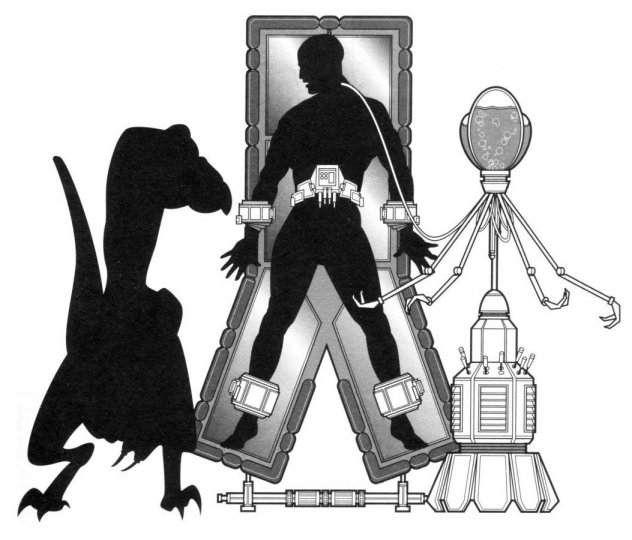
A Ssi-ruu official with a Human captive on an entechment rig.
One thing that made their technology unique compared to the technology utilized by other sentients was the use of entechment—where a living being's life-energy was electronically drained from its body to be used as a power source for a machine. Entechment was the main power source for a wide range of their technology including starships, power stations, Ssi-ruuvi security droids and ion paddle beamers. Although the Ssi-ruuk claimed that entechment was entirely painless, the victims always remained in a state of agony during and after the process of entechment.
Even when installed into power cells and machinery, these disembodied beings remained in continuous agony until their life energies expired into oblivion. Given the excruciating pain and the resulting death of the subject, the Ssi-ruuk did not practice entechment on their own people; preferring to use other "inferior" sentient species particularly P'w'ecks—a similar saurian species which had been reduced to a state of servitude in the ancient past. When the Ssi-ruuk attacked Bakura in 4 ABY, they discovered after taking Imperial prisoners that Humans were a far more powerful source of energy than the P'w'eck.
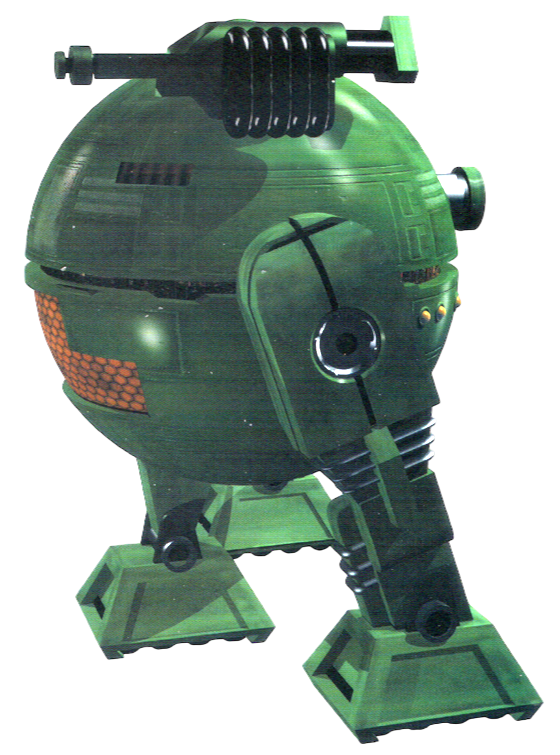
A ssi-ruuvi security droid
By 28 ABY, the entechment process had been perfected. The Ssi-ruuk had found ways to nourish the enteched souls. The life energy distilled from concentrated banks of algae and other microscopic life could prevent the enteched souls from decaying. It also removed the torment many enteched souls felt. Thus, the enteched life energy would be preserved reducing the need for frequent replenishment. The Ssi-ruuk also attempted a second invasion of Bakura, though their plot backfired when their P'w'eck slaves revolted.
Another form of technology unique to the Ssi-ruuk was the ion paddle beamer which was their analog of the ubiquitous blaster rifle used by much of the known galaxy. These paddle beamers were unique in that they were unblockable by lightsabers since the beam would bend around the lightsaber's blade and strike its target. After much practice, Jedi Knight Luke Skywalker managed to change the setting of his lightsaber to block the blast fired from paddle beamers. However, this change in setting meant that the lightsaber was unable to block blaster bolts.

Admiral Ivpikkis around 4 ABY.
The Ssi-ruuk evolved on the planet Lwhekk which was situated in an isolated star cluster on the fringes of the galaxy. Their origins were traced to packs of carnivorous animals on their jungle homeworld. Gradually they formed tribes, each consisted of members with the same skin color. The most dominant were the Blue and Gold scaled tribes. The Blue scaled Ssi-ruuk possessed a great deal of political power, while the Gold-scaled began Ssi-ruuvi religion. These two would form the Ssi-ruuvi upper class. The Ssi-ruuk eventually encountered the smaller yet more common P'w'ecks and conflict arose between the two species. Eventually, the P'w'ecks were subjugated and enslaved. The Blue and Gold tribes then made an alliance and selected the first Shreeftut. The Ssi-ruuvi Imperium was born and the Blue and Gold tribes then subjugated the rest of Lwhekk and divided them into castes. The Conclave and the Elders' Council were formed and eventually the Ssi-ruuk expanded their empire into space. Among the chief issues faced by their race was dwindling natural resources. This combined with the fact that they never developed fusion technology greatly hampered their exploration efforts as the Ssi-ruuk were forced to carry large fuel stores. As such, the Ssi-ruuk initial forays outside their home system were in the search for new sources of energy and resources. The inability to create more efficient energy sources and dwindling resources led to the development of entechment technology. This was the process by which life energies were drawn from living beings and placed within any form of technology to power them. Such a procedure was applied on the P'w'eck race whose energy was tapped to create a stable source of energy which the Ssi-ruuk were able to maintain. Initially, this was considered a distasteful practice by their kind but a necessary approach for energy production.
They eventually began to settle many of the nearby planets. These chain of events saw an expansion into the Ssi-ruuk's star cluster which contained six other inhabitable worlds all of which were conquered with the native races cleansed as part of the testing phase of the entechment process. The practice of entechment of lower life forms became common; even the P'w'ecks, cousins of the Ssi-ruu were used. But gradually it was learned that containment of these "souls" for long periods would result in madness and it was decided that the Imperium needed to expand its realm once again. Another reason was due to the dwindling resources in their isolated region of space. After the discovery of entechment, the Ssi-ruuk sacrificed countless P'w'eck's to power entire hordes of battle droids which they used as part of their forces when they emerged from their stellar cluster. Prior to that, the Imperium had never before dared to expand beyond its cluster, partly because of the large distances involved, partly due to the xenophobic nature of the Ssi-ruuk, and partly because of their religious fear of traveling to 'unconsecrated' worlds. Due to the aforementioned lack of resources, around 100 BBY, the Shreeftut ordered the Imperium to begin expansion, and they spread further than ever before, conquering a wide swath of the Unknown Regions. The Shreeftut pointed to a controversial interpretation of the G'nnoch to justify his actions.
It was known that during the age of the Old Republic, there were scattered references of a reptilian species being encountered in the Outer Rim but it was never determined whether these were Ssi-ruu encountered in that era. As such, it was believed that prior to the Rebellion era, the existence of the Ssi-ruuk was unknown to the greater galactic population.

Ssi-ruuk invade Bakura in 4 ABY.
Previously, the Ssi-ruuk attention was focused outwards but an escalating war with a competing empire ruled by the Chiss led to them making probes to the Core. This expedition was with the intent of harvesting "recruits" to pilot their space fleets. As a result, the Ssi-ruuvi Imperium struck against a number of isolated Outer Rim colonies before clashing with the Imperial Navy. But instead of bringing the Imperial Military to bear against these intruders, the Emperor decided to form a secret pact with the Ssi-ruuk. For their knowledge of entechment, the Emperor secretly agreed to cede several Outer Rim colonies to the Ssi-ruuvi, with which they were to do with as they pleased. In 1 BBY, as the Ssi-Ruuk reached the outlying worlds of the Galactic Empire, the Ssi-ruuvi's supreme ruler—the Shreeftut—received visions through the Force of a hooded Human who revealed himself to be Emperor Palpatine, ruler of the galaxy. He offered the Ssi-ruuvi dozens of worlds and millions of Humans to entech, in exchange for the use of Ssi-ruuvi technology. Thus, they decided to venture into Wild Space, where they conquered the small Human colony of G'rho, capturing and enteching numerous members of the populace. Due to their secret agreement with the Ssi-ruuk, the Imperial leadership covered up the incident and blamed the Alliance to Restore the Republic for the attack.
Among their captives was a Human boy named Dev Sibwarra, whom the Elder Sh'tk'ith brainwashed through mind manipulation techniques. What astounded them was the boy possessed strange powers to sense others. It was from this boy that Ssi-ruuk Admiral Ivpikkis discovered that Humans were the galaxy's dominant species. He also discovered that humanoids had longer containment time when enteched and could last longer than most other species. Due to Sibwarra's Force abilities and his ability to communicate with his fellow Humans, the Ssi-ruuk used Dev Sibwarra to calm the subjects being enteched.
However in 4 ABY, Emperor Palpatine was killed during the Battle of Endor onboard the Second Death Star. With the Emperor unable to fulfill his promise, the Ssi-ruuvi launched an invasion of the edge of the known galaxy. Expeditionary forces were sent out against both the galaxy proper and the neighboring government in the Unknown Regions, the Chiss Ascendancy. However, neither expedition was very successful: the Ssi-ruuvi only narrowly succeeded in conquering the Human world of Cattamascar, and were utterly defeated at Bakura.
Likewise, although several minor Chiss worlds were taken, the Chiss retaliation was massive and unexpected, and laid waste to the Ssi-ruuvi capital, Lwhekk. After the Chiss raid on the Imperium, a small Rebel Alliance task force appeared in Ssi-ruuvi Space. The Rebel force had come to stop the Imperium's expansion into the known galaxy. Seeing the Imperium in ruins, the Rebel Alliance believed that the threat from the Ssi-ruuk was over. The Alliance engaged in diplomatic initiatives to the Ssi-ruuk who were not in a position to wage a war on two fronts. These talks continued for many years and into the New Jedi Order era though these did not eliminate border skirmishes. Ultimately, diplomatic positions remained tense due to the Ssi-ruuk holding nothing but disgust for other species.
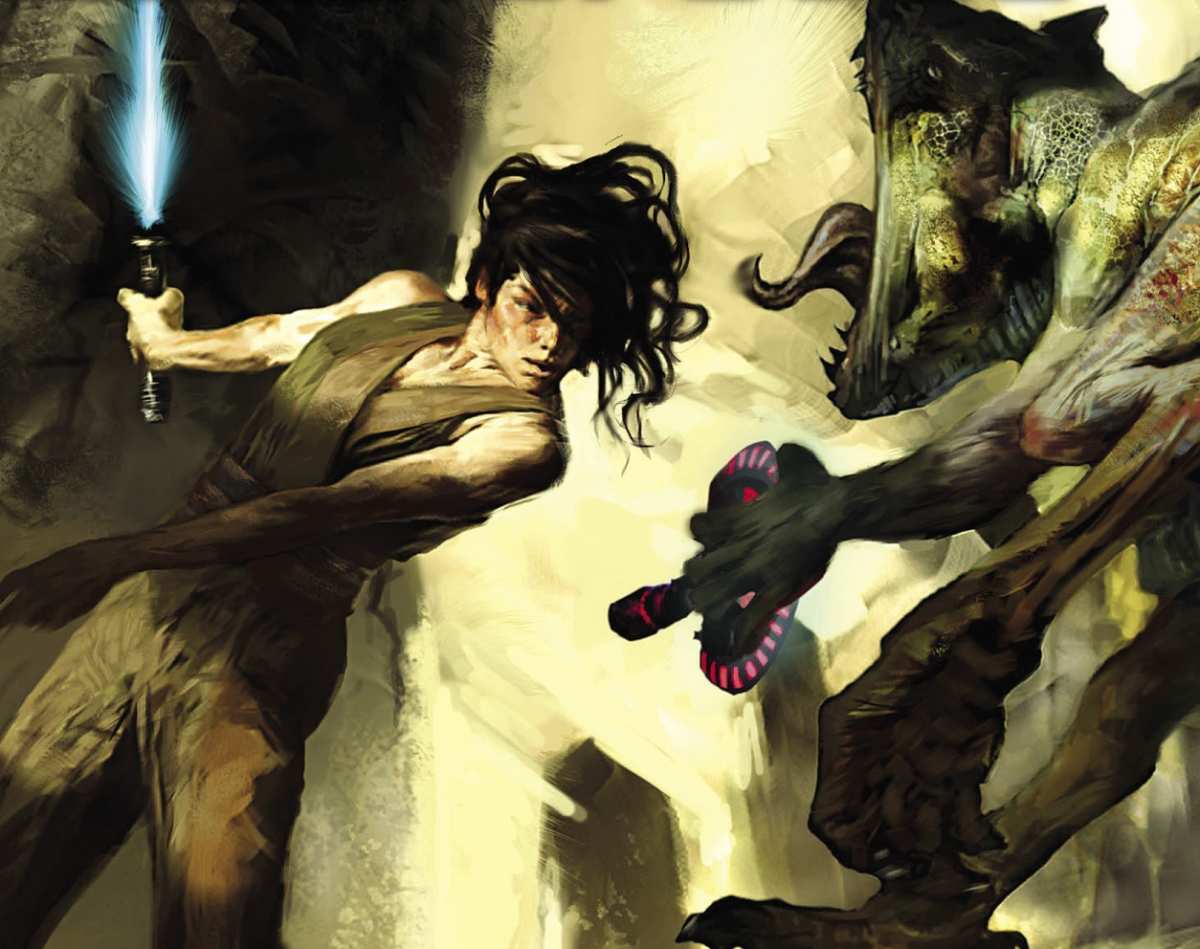
A Ssi-ruu fights Jaina Solo.
It was over twenty years until the Ssi-ruuvi rebuilt enough to contemplate continuing their expansion. During these years, the Ssi-ruuk would discover new techniques of preserving enteched souls. Two major events occurred in that time. One was the birth of the Keeramak, an event of major significance in the Ssi-ruuvi religion. The Keeramak itself, a mutant Ssi-ruu, was a master strategist and politician. The other event was the secret takeover of the Imperium by the Yuuzhan Vong, who secretly infiltrated one of their own, E'thinaa, as a ranking general. The Yuuzhan Vong were well aware of threats throughout the Unknown Regions, and sought to minimize the Ssi-ruuk early on.
Together, E'thinaa and the Keeramak devised a new strategy for continuing the invasion. They made a secret deal with the Prime Minister of Bakura, Molierre Cundertol, and engineered a faux P'w'eck slave uprising, positing the Keeramak as its leader. Together, they succeeded in consecrating Bakura and launching a second invasion of the planet, but when the P'w'eck's actually did revolt and managed to kill the Keeramak, all was lost. Cundertol himself fled back to Lwhekk, where E'thinaa killed him. The P'w'eck revolt managed to overturn the political and religious caste system on Lwhekk, and a military dictatorship was formed under the former soldier caste.
When the Yuuzhan Vong War had ended in 29 ABY, they permissibly abandoned all of the Ssi-ruuk Star Cluster, and with no one in charge of their replacement of the Sector, there was nothing left but a vacuum.
The Ssi'ruk are very similar to carnivorous dinosaurs. In an interview, Tyers said that the Ssi-ruuk were influenced by dinosaurs, specifically books of dinosaurs that had belonged to Tyers's son. When writing the book, Tyers said in an interview with Ilene Rosenberg for Star Wars Adventure Journal 4 that her editor had asked her to have five concepts for the storyline, and the one that Tyers liked the most involved an alien menace that would force the Rebel Alliance and the Empire to briefly work together.
The Unknown Regions campaign guide reverses the position of the green and red caste Ssi-ruu by stating that the former are warriors whilst the latter are workers which contradicts previous material.